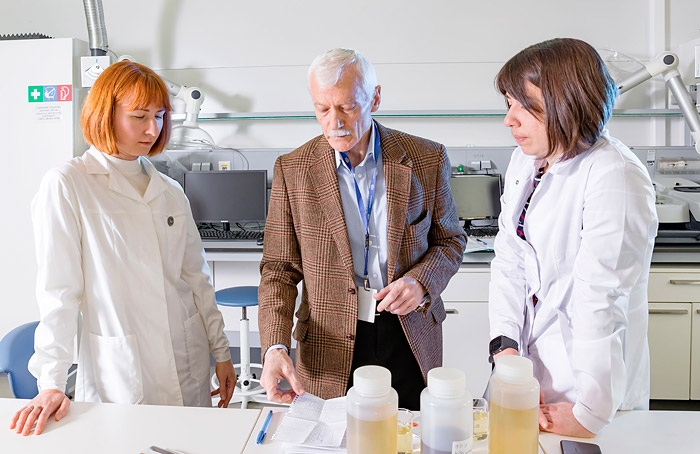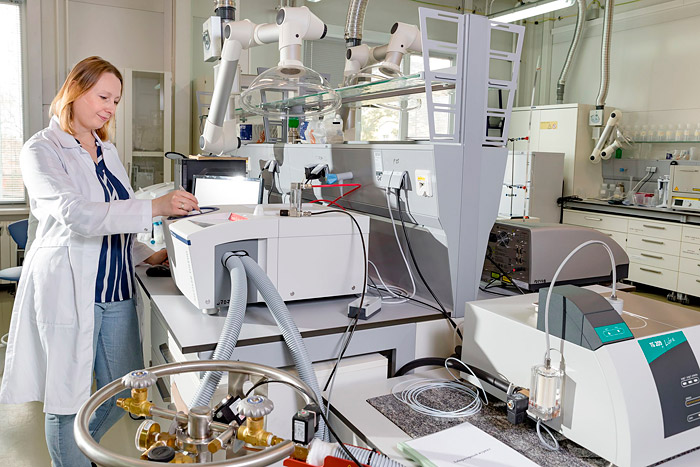
Electronic english version since 2022 |
The newspaper was founded in November 1957
| |
Science to practice
Half a century with "nuclear filters"
(The ending. Beginning at № 45)
A person who carries out applied development has to get used to the fact that of what he or she does, most of it goes to the wastebasket and only rare things enter the market or find at least limited use. Moreover, the higher the probability of success is, the more attempts are made. I regard the Dzhelepov Prize as an award for all the complex work that has resulted in successful implementations, particularly in medicine.
The track etching method allows to produce nanopores in the range from a few nanometers to tens of micrometers. The most science-intensive part of this technology includes pores in a nanometer range. There are the most publications on them and there are many references to our research papers. So far, this has been a completely non-commercial area: research and development of novel miniature devices (sensors, nanofluidic pumps, valves and others) that have not entered the market yet. This is a very interesting topic, with the greatest fundamental contribution. Commercial applications of track membranes are trivial to us, such as, the use of membranes in the treatment of burns. We hope to finally get a registration certificate for this product and the track membrane will become an approved medical device. It turned out that for these purposes the best pore size is 4 microns. At first, it seemed strange that such a membrane would operate better than with 0.2 micron pores that can be a barrier to bacteria. Healthcare professionals have carried out tests and have found out that the wound under the membrane with small pores does not breathe, it gets wet. Such surprises are also interesting. Not all of our track membrane products, even the patented ones, have been implemented. Much less has been implemented than we would like.

Sharing experience or feeding it back to the youth? P.Yu.Apel with O.V.Kristavchuk and I.N.Fadeikina.
And there are completely non-commercial applications, but they are very valuable for me, for they have a useful output that is impossible or difficult to obtain in any other ways. For instance, since the 1970s we have been cooperating with the Physical Institute of the Russian Academy of Sciences, the Sector of X-ray astronomy. They have been studying the Sun for decades, monitoring its state. They launch X-ray telescopes on satellites beyond the Earth's atmosphere that absorbs X-rays. As one of the units of the X-ray telescope, medical professionals at FIAN have used track membranes with preset structural parameters - they cut off a lot of unnecessary radiation and let X-rays through, weakening it so that the detector does not burn. It would seem a small application, but practically significant, for it brings new knowledge about the world around us.
How was the Centre equipped?
If we talk about our new laboratory building, we have obtained the first batch of very good instruments within the project of the International Innovative Nanotechnology Center (IINC) under the programme implemented by the state corporation "Rusnano": two first-rank scanning electron microscopes, an X-ray photoelectron spectrometer, an atomic force microscope with a Raman spectrometer and a host of other current equipment. It was put into operation in 2015 and in subsequent years we expanded the equipment fleet at the expense of the JINR budget, with self-supporting funds and at the expense of grants and cooperation programmes with the Member States of the Institute.
In general, is there enough qualified staff to carry out the operation of all the equipment?

Nikolay Lizunov is studying the structure of a track membrane using a Hitachi SU8020 scanning electron microscope.
There is a bit of a shortage of staff. There are underutilized devices, but the main ones are richly informative, well loaded and provided with qualified personnel. Students come to us, rarely from Moscow universities, mostly from our university. In 2008, I specifically went to teach at Dubna State University at the Department of Chemistry, Geochemistry and Cosmochemistry (currently, it is the Department of Chemistry, New Technologies and Materials) in order to select good students. It was not very efficient: the group is not large, not every year a worthy candidate was found to work in the Centre. From time to time it has worked out and today, several university graduates work with us.
If we talk about staff members, then everything that has been developed using track membranes is the work of a huge number of people, both of DLNP staff members and partners from other institutes that should be remembered. There were enthusiasts from the Ministry of the Electronics Industry of the Soviet Union in the 1970s and 1980s. When we supplied track membranes to SPA "Elektronika" (Voronezh), they were used to manufacture element filters for the final purification of process water, enthusiasts also worked there, who success depended in the most critical way on. B. V. Mchedlishvili (Leningrad Polytechnic Institute) that was involved in biological and medical applications in the 1980s was also a great enthusiast. The partnership in this area has resulted in significant implementations in the technology of obtaining antiviral vaccines, in plasmapheresis, in sanitary and bacteriological analysis. With regard to scientific partnerships, cooperation with foreign companies and laboratories has been particularly interesting and efficient. In the 1990s, after the fall of the Iron Curtain, cooperation with US companies and scientific organizations in Germany, Japan, Great Britain greatly enhanced and allowed to achieve a qualitatively higher level of research. There is a lot to learn from a strong partner. Of the JINR Member States, I would particularly highlight the cooperation with Poland, Romania and the Czech Republic.

The investigation of the thermal properties of membranes on a differential scanning calorimeter
is carried out by Katarzyna Olejniczak (Poland).
This area is 50, you have been working in it for almost 50 years. If you look back...
Yes, I have been working for 47 years and I have passed a gigantic path: from a few water thermostats and optical microscopes at the beginning to the current laboratory building, equipped with first-class equipment. We have at our disposal a compact specialized cyclotron designed by the FLNR staff members that has operated at accelerators. I think no one in the world has the luxury of a heavy ion accelerator exclusively for applied research. Of course, it has limitations in intensity, energy, but nonetheless. The accumulated experience, the amount of knowledge and skills currently and at the initial stage are incomparable things, but this is how it should be for any work started almost from scratch.
Within all these years, we have been supported and guided by FLNR Directorate. First of all, Georgy Flerov that was a man of extraordinary energy, always rich in ideas, with a constant focus on super-tasks. He needed big tasks, small ones were of no interest to him. He was supported by Yuri Oganessian that in 1992 decided to establish a self-supporting department and it was able to survive thanks to mainly international cooperation. The key point was the appointment of Sergey Dmitriev as Head of the Centre that could easily handle practical and commercial tasks at the same time as scientific ones. In keeping with tradition, the FLNR Directors M. G. Itkis, S. N. Dmitriev and S. I. Sidorchuk took care of applied research on the baton. Today, S. N. Dmitriev, having become the Vice-Director of JINR, still supervises us.
The support of FLNR Directorate is an extremely significant factor. After all, when the work on "nuclear filters" was just starting, N. N. Bogolyubov did not approve of the idea of their production at FLNR. He believed that the Institute was involved in fundamental physics, applied things should not be developed here: if you have invented something like that, then transfer it to industry. And Georgy Nikolaevich said: no, if we do not start production here, then nothing will happen. And he turned out to be absolutely right. Recently, we have been at a conference in Tula and have met the representatives of a company that produces filtration equipment. The director of the company says: do you realize that track membranes are the only microfiltration membranes in the country? Indeed, the industry for the production of all other types of polymer membranes, established back in the Soviet Union, perished in the post-perestroika period.
Yu.Ts.Oganessian has recently proposed to join your efforts with those of healthcare professionals and biologists.
Track membranes have been used in medicine and biology since the first days of the establishment of this area. We cooperate with doctors and biologists, but joint work lacks a clear focus on results and the means to achieve this result. Within the framework of our Theme 1131, Yuri Tsolakovich has suggested establishing a group where medical professionals, chemists and biologists will be closely united by a single task and a single directorate. Specialized Moscow organizations, institutes of the National Academy of Sciences of the Republic of Armenia will join it. There are already outlines for organizing the group, it is expected that the corresponding project will be presented at the PAC meeting.
Olga TARANTINA,
photo by Elena Puzynina